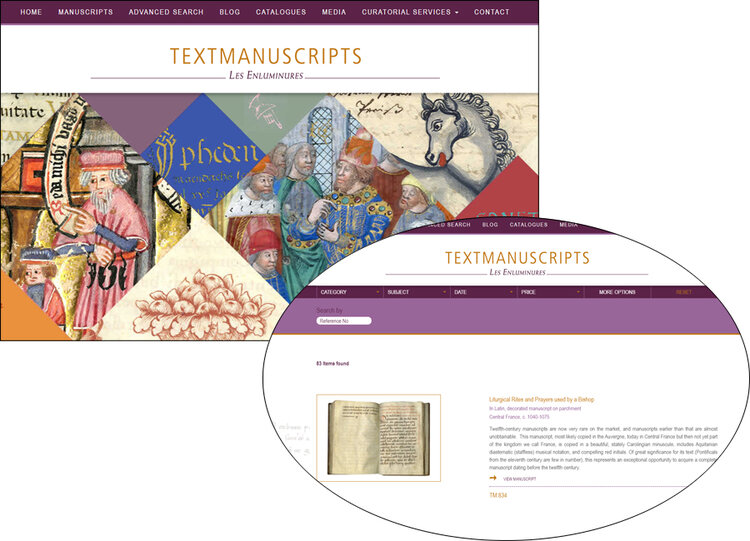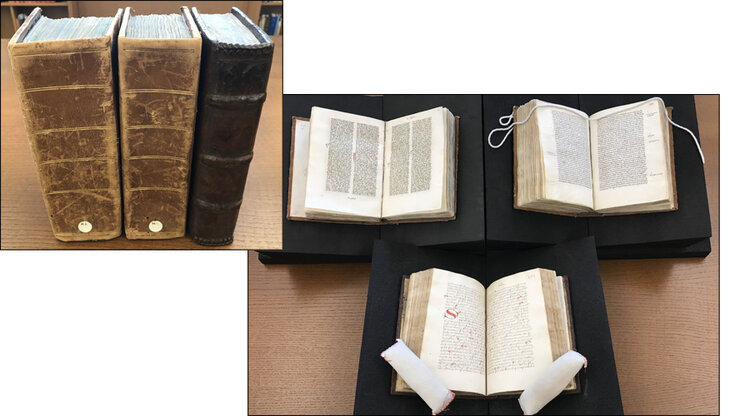
Today’s post is by Dr. Eric J. Johnson, Associate Professor and Curator of Thompson Special Collections, The Ohio State University. Readers of this blog know that all of us at Les Enluminures are proud of our program Manuscripts in the Curriculum (one we always describe as “innovative”). But just wait until you read this post that describes Eric’s response to the difficult realities of teaching a hands-on manuscript class during the pandemic. “Innovative” hardly begins to cover it. Amazing, daring, and ultimately very successful indeed, are equally apropos.
Dr. Johnson holds a M.A. and Ph.D. in Medieval Studies from the Centre for Medieval Studies at the University of York (UK), as well as a M.L.I.S. from Rutgers University. His research interests extend widely across the fields of medieval and Renaissance studies, codicology and bibliography, book history, the pedagogical uses of primary source materials in K-12 and university classrooms, and the digital humanities. He is particularly interested in “fragmentology,” an emerging subfield of manuscript studies invested in the reconstruction of medieval books and the recovery of their dispersed leaves and lost (or obscured) histories.
So, with many congratulations to Eric and his colleague Professor Leslie Lockett, and especially to the students of “Medieval Manuscript Studies" on the success of the class, and on their new manuscripts, I’m delighted to turn over this blog post to Eric.
Laura Light, Les Enluminures
Late-July 2020 was a stressful time for many of us in higher education facing the start of a new semester in the midst of the Covid-19 pandemic. I’ll admit to having been particularly anxious about it all. I’d never before taught in either hybrid or fully online environments, and like so many other instructors I found myself scrambling to come up with ways to help make my students’ “classroom” experience in the fall edifying, engaging, and entertaining.

The Ohio State University, Thompson Special Collections, Rare Book and Manuscript Library. All Photos courtesy of Dr. Eric Johnson.
The “Medieval Manuscript Studies” course (MedRen 5610) I regularly co-teach with my colleague, Prof. Leslie Lockett, for Ohio State’s Center for Medieval and Renaissance Studies had always been a hands-on affair, with students working constantly and intensively with our manuscript collection from the first week of classes until the end of term. Frequent and direct student access to physical manuscripts has always been a hallmark of our class, from quick, in-class exercises designed to teach students about the fine points of codicology and paleography, to more intensive research projects that had students “adopt” a manuscript from our holdings in order to examine thoroughly its textual and artistic contents and histories of production, ownership, and use. Covid-19 changed that. Limited library opening hours, restrictions on in-person meetings, and quarantine policies on collection items all combined to sharply reduce student access to manuscripts. However, while these conditions were challenging, they also inspired us to think about how this situation might lead to new pedagogical opportunities ideally suited to the new hybrid instructional environment.
One of these opportunities quickly became a reality after an anonymous donor contacted me in late-July and offered to provide $50,000 to purchase medieval manuscripts. For years students had asked me how I located, identified, selected, and acquired original manuscript material for Ohio State’s collection, and I’d always dreamed of crafting an assignment that would bring them directly into this curatorial process. While I was aware of assignments at other institutions that asked students to examine library or museum materials for theoretical acquisition, I wasn’t familiar with any that afforded students the opportunity to expend a substantial sum for the actual and practical acquisition of real artifacts. Here was our chance to do something new and meaningful, to provide our students with a unique opportunity that not only would see them learn about medieval manuscripts in a new way, but would also allow them to influence manuscript-based teaching and learning at Ohio State for generations to come.

With our funding in place, I approached Sandra Hindman and Laura Light to see if Les Enluminures would be willing to assist with this project. As one of the few firms with a standing stock of medieval codices large enough to allow me to assign each of my students their own manuscript and diverse enough to enable us to evaluate items produced in a number of locales, in different time periods, covering numerous genres, and offered at a variety of price points, Les Enluminures was ideally suited to our needs. On top of all this, as consummate manuscript scholars and educators themselves, Sandra and Laura were nicely positioned to support our effort.

After reviewing descriptions of approximately 100 of Les Enluminures’ codices, I pre-selected 17 items for our project, assigning one codex for each student to assess as part of a month-long class project. Students examined the detailed dealer description for their manuscript and were then asked to evaluate their codex’s textual and artistic content; historical context; provenance history; and potential teaching, research, and outreach utilities. Additionally, they were required to situate their manuscript within the overall scope of our existing manuscript collection and to discuss the potential “opportunity cost” of the manuscript (or, in other words, calculate and discuss whether the immediate and ongoing scholarly utility of their manuscript justified its monetary price).

Students had two weeks to conduct their individual assessments, after which they shared their work in small groups (3-5 students). During this second phase of the project, each group discussed and evaluated their combined assessments, ranking each manuscript from most to least desirable. The top two manuscripts from each group then became “finalists” for acquisition, and the project culminated in a vibrant live Zoom class session with Les Enluminures in which Sandra and Laura shared additional thoughts and details about the manuscripts—as well as information about their own lives in manuscript studies and the antiquarian book trade. During the session, many of our students shared their own thoughts about the project, one noting that it was “the coolest project that I’ve ever worked on!” Another described the worry she experienced at the thought of being responsible for such a significant financial decision, as well as the exhilaration of being entrusted to be part of such a process. A third student expressed appreciation for the fact that all their careful work to assess and select manuscripts would continue to impact future versions of the course—and the direct experience new generations of students can have with manuscripts at Ohio State.

Ohio State University’s acquisition. From top to bottom, sermons by Cherubino da Spoleto (Spec.Rare.MS.MR.Cod.58), Bernard de Parentis’ popular Treatise on the Office of the Mass (Spec.Rare.MS.MR.Cod.57), and sermons by Antoninus Vercellensis ( Spec.Rare.MS.MR.Cod59).
In the end, a trio of manuscripts emerged as the clear front-runners for acquisition: two sermon compilations, the first by Antoninus Vercellensis (Spec.Rare.MS.MR.Cod59, formerly TM 683) and the second by Cherubino da Spoleto (Spec.Rare.MS.MR.Cod.58, formerly TM 681), and a French priest’s personally-produced copy of Bernard de Parentis’ popular Treatise on the Office of the Mass (Spec.Rare.MS.MR.Cod.57, formerly TM 853). Although the donor’s original bequest fell short of being able to acquire all three codices, the B.H. Breslauer Foundation agreed to support our project by offering a generous cash gift allowing us to purchase the de Parentis manuscript outright. Our anonymous donor’s gift generously covered the cost for the two sermon compilations.

Altogether, these three codices will provide students, teachers, and researchers with countless new scholarly and pedagogical opportunities across an assortment of areas, including social and religious history; pastoralia; manuscript production, transmission, and use; critical editing (none of the three codices have ever been the subject of modern scholarly editions); provenance history; and paleographical and codicological inquiry, to name only a few possible topics. Additionally, all three considerably strengthen Ohio State’s existing collection of medieval pastoral care and moral/practical theological manuscripts (now totaling some 28 codices comprising sermon collections, confessional guides, and pastoral miscellanies—most of them yet to be explored or edited).

As a direct result of this project, a term that began with anxiety and uncertainty quickly transformed into a fun, exciting, and rewarding experience on a number of levels. Our students learned about manuscripts in a novel and enjoyable way that allowed them to put their growing knowledge to practical and impactful use while also giving them a direct stake in both the present and future of manuscript studies at Ohio State. Our anonymous donor and the Breslauer Foundation were able to see their gifts have an immediate and real impact on the lives and experiences of students, as well as on the long-term growth of our manuscript collection. Finally, Sandra, Laura, and all the great folks at Les Enluminures helped show our students that medieval manuscripts remain alive in the world and aren’t just objects of quiet study or reverent display. Rather, manuscripts are agents of excitement that can engage modern users on a number of levels. Moreover, they’re also builders of community.
Eric J. Johnson, Assoc. Professor and Curator of Thompson Special Collections, The Ohio State University
*With thanks to our anonymous donor, the B.H. Breslauer Foundation, Sandra Hindman, Laura Light, and the entire staff of Les Enluminures.
You can now receive periodic blog post updates by submitting your email up above in “Follow Us.” Make sure to follow us also on Instagram (@lesenluminures), Facebook (Les Enluminures) and at our Twitter (@LesEnluminures)!


